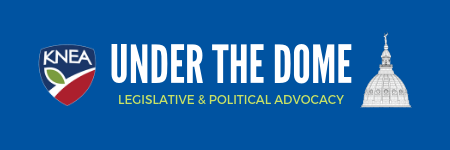 These early days of a legislative session leave us wondering what we have to report to you every day! Legislators might be thought of as “hunter/gatherers.” While hunting for ideas and solutions, the spend a lot of time gathering information.
These early days of a legislative session leave us wondering what we have to report to you every day! Legislators might be thought of as “hunter/gatherers.” While hunting for ideas and solutions, the spend a lot of time gathering information.
So it has been so far this year. In the committees we follow most closely – Appropriations, Ways and Means, the Tax Committees, the Education Committees, and the Education Budget Committees – we have been treated to many of the same presentations. These include:
- Reviews of the impact of SB 19, the tax bill passed last session. What we know- Things are looking up but it’s still early – we should know a lot by April. And the new federal tax bill is likely to help make our revenue picture a “wild ride” (legislative staff said that not us!) with the first impact being a large influx of income tax cash as taxpayers sent in their last estimated tax payments in December rather than January to ensure those payments could still be deductible on their 2017 federal income tax form.
- Reviews of the deliberations of the Special Committee on a Comprehensive Response to the School Finance Decision. This committee assembled a collection of data but chose not to forward any recommendations to the full legislature. The most talked about part of their report is their study of the impact of an 18% cut to all state agencies except K-12 education as a means of raising the $600 million they believe is needed to meet the Court’s ruling.
- Reviews of the evolution of the education article in the Kansas Constitution (Article VI). The current language was drafted by a legislative committee in 1965 and by the public in 1966. Prior to 1966, it was the language of the Wyandotte Constitution. A number of legislators have been floating the idea of pressing a constitutional amendment to stop the Supreme Court from determining the school funding formula to be unconstitutional on the basis of adequacy.
- Reviews for recent changes to KPERS including the impact on the unfunded actuarial liability of withholding state KPERS contributions as part of balancing the budget.
- Presentations by Education Commissioner Randy Watson on the state of education in Kansas today.
It’s a lot of data!
Is $600 million the number?
It would seem that $600 million is the number under the dome. The Governor proposed $600 million, meeting the SBOE or the three-judge panel recommendations would take about $600 million, the Special Committee premised their discussion including consideration of budget cuts to raise $600 million, so it sounds a lot like consensus. (We recognize that there is a core group of legislators who don’t want to increase school funding at all.)
But of course, at the same time, the legislature has contracted for a new school funding study. That study is expected to be presented to the legislature on March 15. And that’s another problem.
The Court expects briefs to be filed on April 30. Attorney General Schmidt and the state’s attorney, Art Chalmers, both asked the legislature to finish their work by March 1 in order to meet that deadline. A few legislators have begun to float the idea of waiting until that study is complete. But to do so would jeopardize their ability to argue in the Supreme Court.
There are several things the legislature needs to do to get this task accomplished.
- They need to deal with the four unconstitutional inequities in the new formula. This is a relatively easy task and Rep. Melissa Rooker (R-Fairway) has already filed a bill to fix those problems (HB 2445).
- With that done, they can focus on the level of funding they need. Again, the SBOE, the three-judge panel, and the Governor have all indicated about $600 million.
- They need to decide how to put that money into the system. The Governor suggested a five-year phase-in. We don’t know if the Court will accept a time frame of that length but most people agree there will be some kind of phase-in.
- And finally, they need to make sure the money is available. They must show the Court that they are serious by presenting evidence that the money for a phase-in will actually be there. This might take additional revenue measures and it will certainly include evidence of increasing revenue collections.
These are the discussions we hope to see beginning very soon.


